Why Is Winter Considered the Best Time to Visit Keoladeo National Park?
Did you know that over 370 species of birds descend upon a single wetland in Rajasthan every winter, transforming it into one of Asia’s most spectacular avian gatherings? This remarkable phenomenon happens at Keoladeo National Park, where the best time to visit Keoladeo National Park coincides with nature’s grandest show. Understanding when to plan your journey can mean the difference between witnessing thousands of migratory birds or walking through quiet trails.
Choosing the right season transforms your experience from ordinary to extraordinary. The Bharatpur bird sanctuary ideal time matters because weather, wildlife activity, and visitor comfort all peak during specific months. Travel The World Today guides you through every stage of planning your perfect visit to this UNESCO World Heritage Site.
Understanding Keoladeo National Park’s Climate Patterns
Year-Round Weather Overview
Keoladeo Ghana National Park experiences three distinct seasons that dramatically affect your visit. Summer temperatures soar between April and June, reaching 45°C (113°F) with scorching conditions. The monsoon at Keoladeo National Park arrives in July and continues through September, bringing heavy rainfall and humid conditions. Winter spans October through March, offering the most comfortable Keoladeo National Park weather for exploration.
Your comfort depends heavily on understanding these patterns. Keoladeo National Park temperature by month varies significantly, impacting both wildlife visibility and your ability to explore. Summer heat makes midday safaris uncomfortable, while monsoon flooding restricts access to certain areas.
How Weather Affects Wildlife Viewing
Temperature directly influences animal behavior and your viewing opportunities. Birds remain most active during cooler morning hours in winter season in Keoladeo National Park. Hot afternoons drive wildlife into shade, reducing sightings dramatically. Water levels fluctuate with seasons, concentrating or dispersing aquatic birds across the sanctuary.
The Keoladeo National Park bird migration time aligns perfectly with winter’s arrival. Cooler temperatures trigger migration patterns, bringing species from Siberia, Central Asia, and Europe. This natural synchronization makes timing crucial for witnessing peak biodiversity.
Why Winter Stands Out as Peak Season
The Migratory Bird Phenomenon
Winter transforms Keoladeo into a birding paradise through spectacular migration events. Between October and March, migratory birds in Keoladeo National Park arrive in waves from distant breeding grounds. You’ll spot rare species like the Siberian Crane (occasionally), Greater Spotted Eagle, and Common Crane alongside thousands of waterfowl.
When birds migrate to Keoladeo National Park, they seek warm winter refuge and abundant food sources. The sanctuary’s wetlands provide ideal habitat with shallow waters supporting fish, invertebrates, and aquatic vegetation. This biological wealth attracts approximately 230 bird species during peak months.
The birdwatching season in Bharatpur offers unparalleled diversity. Early morning walks reveal painted storks, spoonbills, pelicans, and countless duck species. Professional birders and photographers worldwide recognize this period as Asia’s premier birding destination.
Optimal Weather Conditions
Winter provides perfect conditions for extended outdoor exploration. Daytime temperatures range from 12°C to 25°C (54°F to 77°F), allowing comfortable all-day safaris. Clear skies and minimal rainfall ensure consistent access to all sanctuary zones. Morning fog occasionally adds mystical beauty to your photography without hindering visibility.
Ideal weather for visiting Keoladeo National Park combines pleasant temperatures with low humidity. You can walk or cycle through 29 kilometers of trails without heat exhaustion concerns. Evening safaris remain enjoyable as temperatures cool gradually after sunset.
The Bharatpur sanctuary winter guide emphasizes comfortable clothing layers. Mornings start crisp, requiring light jackets, while afternoons warm pleasantly. This temperature range keeps both visitors and wildlife active throughout daylight hours.
Month-by-Month Winter Breakdown
November: Migration Begins
Keoladeo National Park in November marks the migration season’s official opening. Early arrivals include bar-headed geese, common teals, and northern pintails. Water levels stabilize after monsoon, creating optimal feeding zones for waterfowl. Temperatures drop to comfortable ranges, averaging 15°C to 28°C (59°F to 82°F).
You’ll encounter fewer crowds during November compared to December and January. This advantage allows peaceful exploration and better photography opportunities. The Keoladeo sanctuary weather in winter begins shifting, bringing crisp mornings ideal for dawn safaris.
Bird activity increases daily as more species arrive. Your sighting list grows impressively week by week throughout November. Local guides report this month offers excellent value with lower accommodation rates and available safari slots.
December: Peak Diversity
Keoladeo National Park in December showcases maximum bird diversity and activity. Migration reaches full momentum with species from Europe, Central Asia, and Siberia settling into winter territories. You’ll observe complex behavioral patterns including courtship displays, territorial disputes, and feeding strategies.
December temperatures range from 8°C to 23°C (46°F to 73°F), requiring warm morning layers. Visibility remains excellent with minimal fog interference. The peak season for Keoladeo bird sanctuary begins attracting serious birders and wildlife photographers globally.
Water bodies teem with life as resident and migratory species interact. Raptors including various eagle species hunt across grasslands. Your December visit captures nature’s winter spectacle at its absolute zenith.
January: Prime Viewing Month
Keoladeo National Park in January represents the absolute best month to visit Keoladeo National Park for comprehensive wildlife experiences. All migratory species have established presence, and bird populations reach maximum density. Cooler temperatures between 7°C and 22°C (45°F to 72°F) keep wildlife active longer.
Photography conditions excel during January with golden morning light and clear atmospheres. The annual Bharatpur bird festival dates typically occur in January, celebrating the sanctuary’s avian wealth. Professional naturalists lead specialized tours during this premium period.
January mornings require warm clothing as temperatures occasionally touch 5°C (41°F). Afternoon warmth provides comfortable exploration without summer’s oppressive heat. This balance makes January ideal for families, seniors, and first-time visitors.
February: Extended Season
Keoladeo National Park in February extends excellent viewing opportunities before migration reverses. Early month conditions mirror January’s advantages with slightly warmer temperatures. Late February sees gradual departures as birds begin returning to breeding grounds.
You’ll still encounter impressive diversity through mid-February. Temperatures climb toward 10°C to 26°C (50°F to 79°F), signaling winter’s gradual end. The Keoladeo Ghana National Park winter tourism season maintains quality through February despite decreasing bird numbers.
February offers advantages for budget-conscious travelers. Accommodation prices begin dropping as peak season wanes. You’ll experience fewer crowds while maintaining good wildlife sighting opportunities.
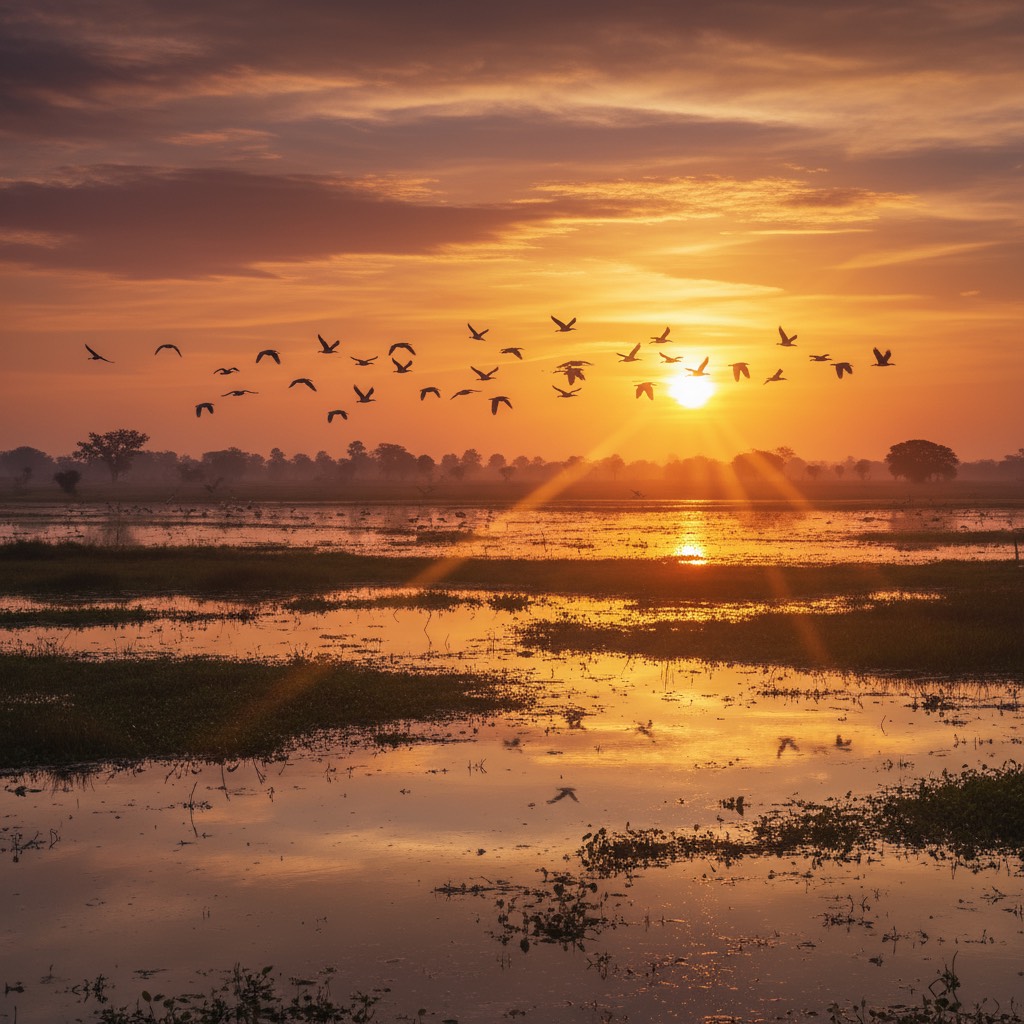
Comparing Other Seasons
October and March: Shoulder Seasons
Keoladeo National Park in October represents the pre-winter transition phase. Early migratory birds arrive while summer heat diminishes. Temperatures remain slightly elevated at 18°C to 32°C (64°F to 90°F), making extended walks challenging during midday hours.
Keoladeo National Park in March marks winter’s departure and spring’s arrival. Late migrants linger while temperatures begin climbing toward 15°C to 30°C (59°F to 86°F). These shoulder months offer reduced crowds and lower costs but compromised wildlife viewing compared to peak winter.
The Keoladeo National Park tourist season extends through these months for visitors prioritizing solitude over maximum diversity. Serious birders typically avoid October and March unless targeting specific early or late migrants.
Summer: The Challenge Season
Summer travel to Keoladeo National Park tests even dedicated wildlife enthusiasts. April through June temperatures frequently exceed 40°C (104°F), creating dangerous conditions for extended outdoor activity. Most migratory birds have departed, leaving only heat-adapted resident species.
Wildlife viewing becomes extremely limited during summer months. Birds remain inactive during scorching midday periods, seeking shade and water. Early morning safaris between 6:00 AM and 9:00 AM provide the only comfortable viewing window.
The off-season at Keoladeo National Park does offer absolute solitude and rock-bottom accommodation rates. However, physical discomfort and minimal wildlife sightings make summer visits worthwhile only for researchers or extreme budget travelers.
Monsoon: The Renewal Period
Monsoon season brings life-giving rains between July and September but creates challenging visiting conditions. Heavy rainfall floods trails, restricts access, and reduces visibility. The sanctuary essentially closes for renovation and recovery during peak monsoon months.
Resident bird species begin nesting during monsoon, offering specialized interest for breeding behavior enthusiasts. However, humidity, insects, and muddy conditions deter most casual visitors. Keoladeo National Park seasonal wildlife viewing focuses on aquatic adaptations during this period.
Post-monsoon September shows promise as waters recede and temperatures moderate. The landscape transforms into lush greenery, though migratory birds haven’t yet arrived. Consider September only if combining your visit with other Rajasthan destinations.
Planning Your Winter Visit
Best Timing Within Winter Months
Your ideal visit window depends on specific interests and priorities. When to visit Keoladeo Ghana sanctuary centers on December through January for maximum diversity. November suits budget-focused travelers willing to sacrifice some species variety. February works for those avoiding peak crowds while maintaining good viewing.
The timing for Bharatpur bird sanctuary should align with your photography goals. Golden hour lighting occurs between 6:30 AM to 8:00 AM and 4:30 PM to 6:00 PM during winter. Mid-morning through afternoon provides harsh overhead light less suitable for quality images.
Ideal time for Bharatpur nature lovers incorporates personal comfort preferences. Early winter (November) offers warmer days, while deep winter (December-January) provides crisp, refreshing conditions. Late winter (February) transitions toward spring warmth.
Duration and Safari Planning
Plan minimum two full days to appreciate Keoladeo’s diversity properly. Three days allows comprehensive coverage of all sanctuary zones and multiple safari timings. Dedicated birders often spend four to five days cataloging species and capturing behavioral photography.
Bharatpur National Park visiting hours run from sunrise to sunset year-round. Winter sunrise occurs around 7:00 AM, with sunset near 6:00 PM. Gates open 30 minutes before sunrise, allowing early positioning for dawn activity.
Keoladeo National Park morning safari timing proves crucial for maximum sightings. Arrive at gates by 6:30 AM during winter for optimal positioning. Morning coolness triggers peak bird activity, feeding, and vocalizations. Afternoon sessions from 3:00 PM to sunset offer secondary opportunities.
Transportation and Exploration Methods
The sanctuary offers multiple exploration options suiting different fitness levels and budgets. Walking remains the most immersive method, allowing silent approach and detailed observation. The flat terrain accommodates all age groups for the sanctuary’s 29-kilometer trail network.
Bicycle rentals provide efficient coverage of larger areas. Cycling lets you reach distant zones while maintaining wildlife-friendly silence. Rental shops near the entrance offer hourly and daily rates starting from ₹50-100.
Cycle-rickshaw tours with trained guides offer comfort and local expertise. Guides identify species, explain behaviors, and position you for optimal photography. Three-hour rickshaw tours cost approximately ₹150-300, representing excellent value for first-time visitors.
Essential Visitor Information
Entry Requirements and Costs
| Visitor Category | Entry Fee | Camera Fee | Vehicle Fee |
|---|---|---|---|
| Indian Adults | ₹75 | ₹200 (Still) | ₹125 (Cycle) |
| Indian Children | ₹25 | ₹500 (Video) | ₹200 (Rickshaw) |
| Foreign Adults | ₹500 | Same as above | Same as above |
| Foreign Children | ₹200 | Same as above | Same as above |
Keoladeo Ghana National Park visitor information includes these standard charges applicable throughout the year. Purchase tickets at the main entrance gate before proceeding. Group discounts aren’t typically available for entry fees.
Professional photography requires special permissions for commercial use. Contact the park administration in advance if shooting for publications or commercial projects. Personal photography falls under standard camera fee requirements.
Accommodation Options
How to plan Bharatpur bird sanctuary visit includes securing appropriate lodging. Bharatpur city offers options ranging from budget guesthouses (₹800-1500) to luxury heritage properties (₹5000-15000). Book well ahead for December and January when demand peaks.
Properties near the sanctuary entrance provide convenient early morning access. The Forest Lodge inside the sanctuary offers unique overnight experiences but requires advance booking through Rajasthan Tourism. Several resorts position themselves within 2-3 kilometers of entrance gates.
Winter accommodation prices increase 30-50% during peak months (December-January). Consider booking November or February visits for better rates. Mid-week stays typically cost less than weekends throughout winter.
What to Pack for Winter Visits
Your winter packing list should emphasize layering for temperature fluctuations:
- Warm morning layers: Fleece jacket, light sweater, full-sleeve shirts
- Comfortable afternoon clothes: Cotton shirts, light pants, breathable fabrics
- Footwear: Sturdy walking shoes, thick socks for morning cold
- Accessories: Wide-brimmed hat, sunglasses, sunscreen (SPF 30+)
- Birding equipment: Binoculars (8×42 or 10×42), field guide, notebook
- Photography gear: DSLR with telephoto lens (300mm minimum), extra batteries
- Hydration: Reusable water bottle, light snacks
- Protection: Insect repellent, basic first-aid kit
Keoladeo National Park travel tips stress comfortable, neutral-colored clothing. Avoid bright colors that disturb wildlife. Quiet fabrics prevent rustling that alerts birds to your presence.
Maximizing Your Birding Experience
Hiring Local Guides
Tourist guide to Keoladeo National Park services dramatically enhance your experience and species identification success. Licensed local guides possess decades of sanctuary knowledge, recognizing birds by calls before visual confirmation. Their expertise helps locate rare species and predict movement patterns.
Guide rates range from ₹500-1000 for half-day services and ₹1000-1500 for full days. This investment proves invaluable for first-time visitors and serious birders alike. Guides speak multiple languages and understand international bird naming conventions.
Book guides through your accommodation or directly at sanctuary entrance. Many experienced guides maintain social media presence showing recent sightings. Research beforehand to select guides specializing in photography, rare species, or comprehensive tours matching your interests.
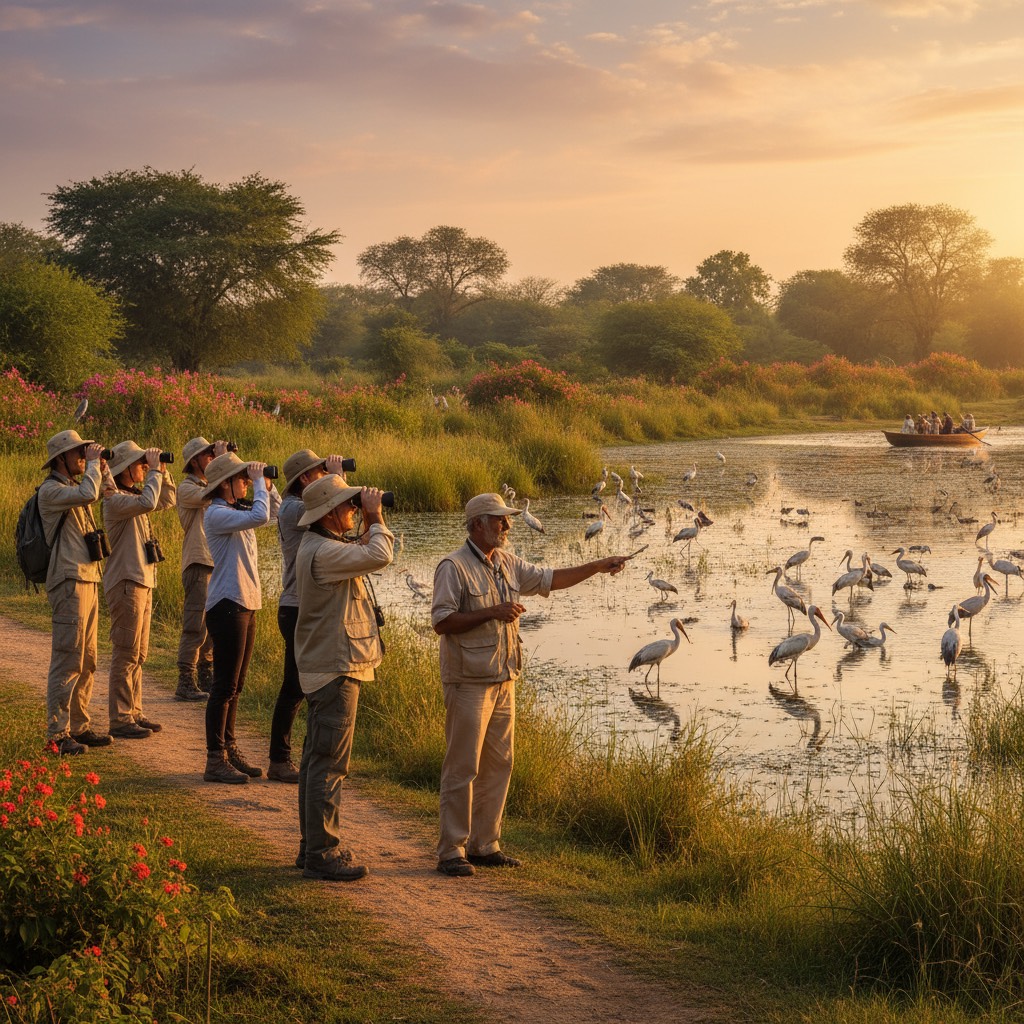
Photography Best Practices
Bird photography season Bharatpur demands specific technical approaches. Use telephoto lenses (400mm-600mm) for frame-filling images of distant subjects. Tripods or monopods stabilize equipment during long observation periods. Fast shutter speeds (1/1000s minimum) freeze bird movement.
Keoladeo National Park photography season benefits from winter’s soft light and bird density. Position yourself with sun behind you during morning and afternoon golden hours. Overcast days provide even lighting reducing harsh shadows.
Respect minimum approach distances preventing stress to wildlife. Never use playback calls to attract birds as this disrupts natural behaviors. Patient observation from fixed positions yields better results than constant movement.
Species Checklist and Targets
Create a target species list before visiting to maximize satisfaction:
Premier Migratory Targets:
- Greylag Goose
- Bar-headed Goose
- Common Crane
- Demoiselle Crane
- Greater Spotted Eagle
- Imperial Eagle
- Sarus Crane (resident)
- Painted Stork
- Asian Openbill
- Black-necked Stork
Residential Highlights:
- Indian Python
- Nilgai (Blue Bull)
- Sambar Deer
- Golden Jackal
- Jungle Cat
- Various owl species
Best weather to see migratory birds in Bharatpur occurs during clear winter mornings when bird activity peaks. Target wetland areas early, transitioning to woodland zones as day warms. Evening sessions focus on roosting behaviors and raptor activity.
Beyond Birdwatching
Other Wildlife Encounters
Wildlife tourism in Keoladeo National Park extends beyond avian species. The sanctuary supports healthy mammal populations including Nilgai, Sambar Deer, and Spotted Deer. Golden Jackals patrol trails during early morning and late evening hours.
Indian Pythons occasionally sun themselves near water bodies during cooler months. Multiple mongoose species exhibit active hunting behaviors throughout the day. Wild Boar families forage in shallow waters and grassland edges.
Reptile diversity includes various turtle species, monitor lizards, and numerous snake species. Winter reduces reptile activity compared to summer, but patient observation reveals their presence. Dawn and dusk provide optimal viewing times for mammals.
Cultural and Historical Context
Keoladeo’s history as a royal hunting preserve adds fascinating cultural dimensions. The Maharajas of Bharatpur developed this wetland in the 1850s, transforming it into one of India’s finest waterfowl hunting grounds. Historical records document kills exceeding 4,000 birds in single days during colonial times.
The sanctuary achieved National Park status in 1982 and UNESCO World Heritage designation in 1985. This transition from hunting ground to conservation area represents India’s evolving environmental consciousness. Former royal hunting lodges now serve as administrative buildings and visitor facilities.
Local communities maintain traditional connections with the sanctuary. Understanding this cultural backdrop enriches your appreciation of conservation achievements. Several interpretation centers explain the area’s transformation and ongoing protection efforts.
Practical Travel Logistics
Reaching Bharatpur
Keoladeo National Park trip planner begins with transportation arrangements. Bharatpur city connects well with major Indian destinations through multiple options:
By Rail: Bharatpur Junction receives trains from Delhi (3-4 hours), Jaipur (2.5 hours), and Agra (1 hour). The railway station sits 5 kilometers from sanctuary entrance. Auto-rickshaws and taxis provide convenient transfers.
By Road: Well-maintained highways connect Bharatpur to Delhi (180 km), Agra (55 km), and Jaipur (180 km). State transport buses run regularly. Private taxis offer comfortable point-to-point service at reasonable rates.
By Air: Agra airport (60 km) and Jaipur airport (180 km) serve as nearest aviation gateways. Delhi’s Indira Gandhi International Airport (210 km) offers maximum connectivity with pre-arranged ground transportation.
Combining with Other Destinations
Rajasthan winter wildlife destinations pair excellently with Keoladeo National Park. Create comprehensive itineraries combining multiple attractions:
The Golden Triangle Extension:
- Day 1-2: Delhi sightseeing
- Day 3-5: Bharatpur/Keoladeo National Park
- Day 6-7: Agra (Taj Mahal, Agra Fort)
- Day 8-10: Jaipur (Amber Fort, City Palace)
Wildlife Circuit:
- Ranthambore National Park (tiger viewing, 210 km)
- Sariska Tiger Reserve (160 km)
- Chambal River Sanctuary (gharial and dolphins, 80 km)
Rajasthan wildlife parks best time to visit aligns perfectly across these destinations during winter months. Combine tiger safaris with birding for comprehensive wildlife experiences.
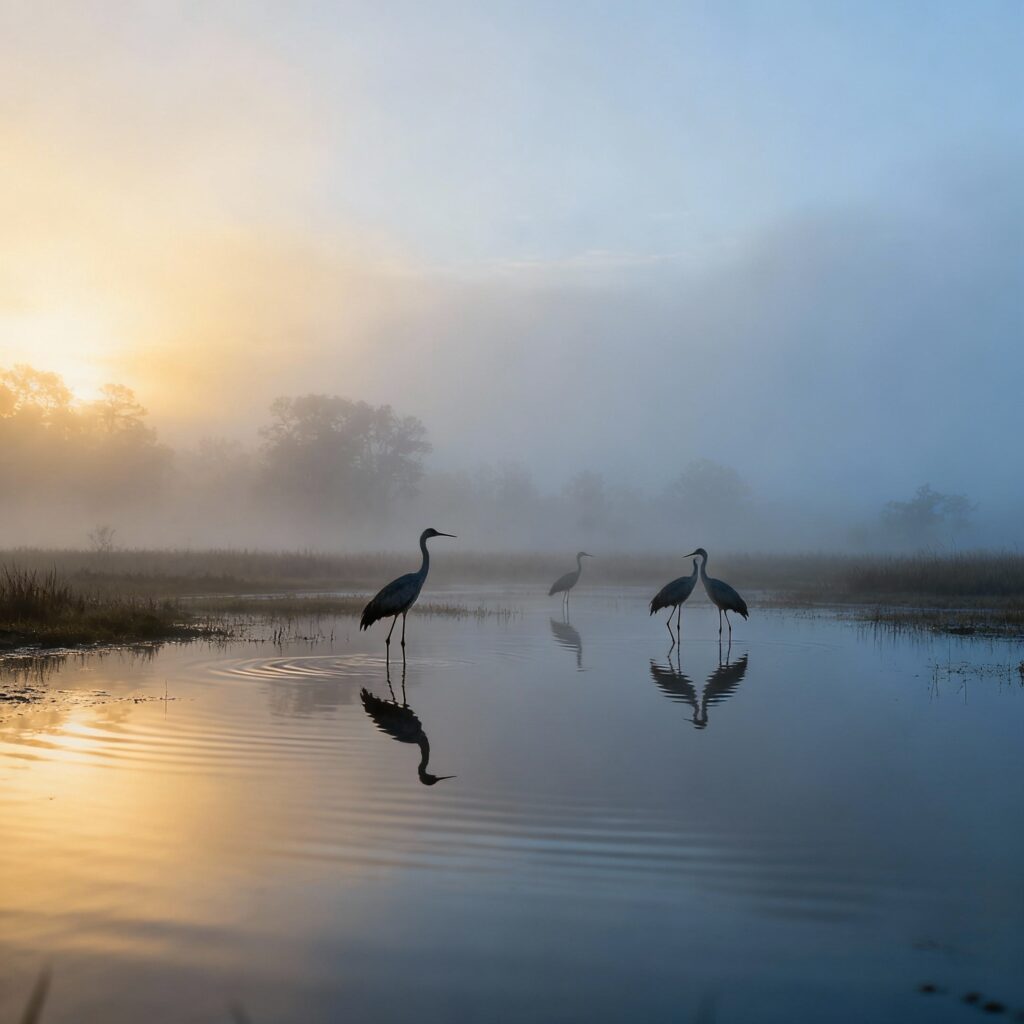
Local Facilities and Services
Bharatpur town provides complete visitor amenities. Multiple ATMs, medical facilities, pharmacies, and restaurants serve tourist needs. Internet connectivity remains reliable throughout town and many sanctuary areas.
Restaurant options range from local Rajasthani cuisine to international fare. Vegetarian food predominates but non-vegetarian options exist. Several establishments cater specifically to early-morning birders with pre-dawn meal services.
Mobile network coverage remains strong throughout the sanctuary. Emergency contacts include sanctuary office (+91-5644-222777) and local police (100). Medical emergencies can be directed to district hospital facilities in Bharatpur.
Environmental and Conservation Awareness
Current Conservation Challenges
Understanding Keoladeo National Park seasonal wildlife patterns requires awareness of conservation pressures. Water availability remains the sanctuary’s primary challenge. Competing demands from agriculture and urban development threaten adequate water flows into wetlands.
The Siberian Crane, once Keoladeo’s star attraction, hasn’t visited since 2002 due to habitat loss along migration routes. This loss underscores global conservation interdependence. Other species face similar pressures from climate change and development.
Invasive species management requires ongoing efforts. Water hyacinth and Prosopis juliflora (mesquite) threaten native vegetation. Sanctuary staff conduct regular removal operations maintaining habitat quality for birds and other wildlife.
Responsible Visiting Practices
Your visit should support conservation while minimizing environmental impact:
- Stay on designated trails: Off-path walking damages vegetation and disturbs wildlife
- Maintain silence: Loud conversations and music stress birds and reduce others’ experiences
- No littering: Carry all waste out; plastic pollution threatens aquatic life
- Respect photography distances: Never approach nests or disturb feeding birds
- Support local economy: Purchase from local guides, shops, and accommodations
- Water conservation: Use lodging water resources responsibly
- Report violations: Inform authorities about poaching or rule violations
Bharatpur eco tourism season guide emphasizes visitor responsibility in maintaining sanctuary quality. Your adherence to guidelines ensures future generations enjoy similar experiences.
Key Takeaways for Your Visit
Understanding when to visit Keoladeo National Park fundamentally shapes your experience. Winter months from November through February provide unmatched advantages combining comfortable weather, maximum bird diversity, and optimal viewing conditions. January stands out as the peak month balancing all factors perfectly.
Your Keoladeo National Park trip planner should prioritize early morning arrivals, local guide services, and multiple days for comprehensive coverage. The relatively small investment in professional guidance multiplies your species identification success and overall satisfaction.
Migratory bird timing Bharatpur sanctuary centers on the November-to-February window when approximately 230 bird species inhabit the wetlands. This natural spectacle represents one of Asia’s premier wildlife viewing opportunities accessible to visitors of all experience levels.
Budget considerations favor November and February visits when accommodation costs drop while maintaining good wildlife viewing. Peak months (December-January) justify premium rates through maximized diversity and ideal conditions.
Conclusion
Winter’s reign as the best time to visit Keoladeo National Park stems from perfect convergence of multiple factors. Comfortable temperatures between 7°C and 25°C allow all-day exploration without physical stress. Migratory birds arrive in spectacular numbers, transforming the sanctuary into a biodiversity hotspot recognized globally. Clear skies, excellent visibility, and stable weather ensure consistent access to all sanctuary zones.
The Keoladeo Ghana National Park weather during winter creates optimal conditions for both wildlife and visitors. Birds remain active throughout daylight hours, feeding and displaying natural behaviors. Photographers capture stunning images in golden winter light. Families explore safely on flat, accessible trails.
Your decision about best month to visit Keoladeo National Park should weigh personal priorities against seasonal advantages. January offers absolute peak experiences worth premium prices. November and February provide excellent value with slightly reduced but still impressive wildlife populations. December balances all factors for those with scheduling flexibility.
Travel The World Today guides you in every stage of planning your Keoladeo adventure. From understanding seasonal patterns to booking accommodations and arranging local guides, proper preparation ensures memorable encounters with nature’s winter spectacle. This UNESCO World Heritage Site rewards winter visitors with experiences found nowhere else in India.
The Bharatpur bird sanctuary ideal time coincides with winter for undeniable reasons. No other season matches the combination of comfortable conditions, spectacular wildlife diversity, and reliable viewing opportunities. Your winter journey to Keoladeo National Park promises encounters with nature’s remarkable adaptations and migrations.
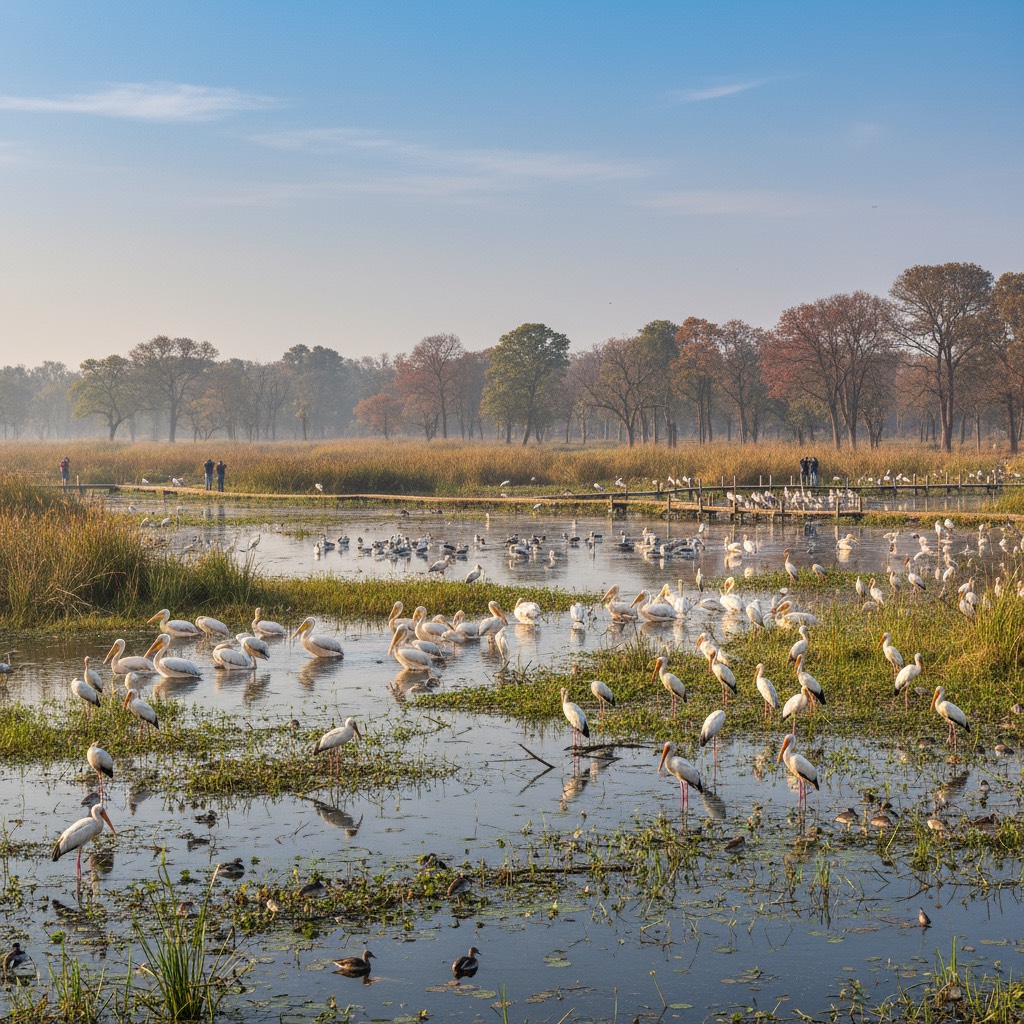
Take Action: Plan Your Winter Birding Adventure
Ready to witness one of Asia’s greatest wildlife spectacles? Start planning your winter visit to Keoladeo National Park today. Research accommodation options in Bharatpur matching your budget and preferences. Book December or January dates well ahead for peak season access.
Contact local guide services to arrange expert-led tours maximizing your species sightings. Prepare appropriate clothing, photography equipment, and field guides for comprehensive birding experiences. Consider extending your trip to include nearby Agra and Jaipur for complete Golden Triangle experiences.
Travel The World Today encourages you to experience winter’s magic at Keoladeo National Park. Join thousands of annual visitors discovering why this sanctuary earned UNESCO recognition. Your winter adventure awaits where migratory birds gather in remarkable numbers against Rajasthan’s cultural backdrop.
Don’t delay—the best time to visit Keoladeo National Park happens once yearly during winter months. Secure your dates, pack your binoculars, and prepare for unforgettable wildlife encounters. Keoladeo National Park’s winter wonders promise memories lasting far beyond your visit.
Travel The World Today provides comprehensive destination guides helping you experience the planet’s remarkable diversity. Explore our resources for expert travel planning across India’s wildlife destinations and beyond.
Frequently Asked Questions
Q: What is the absolute best single month to visit Keoladeo National Park?
January represents the optimal single month combining maximum bird diversity, comfortable weather, and peak wildlife activity. However, December runs a close second with similar advantages and potentially fewer crowds.
Q: Can I visit Keoladeo National Park during monsoon?
The sanctuary remains technically open during monsoon (July-September), but heavy flooding restricts access to many areas. Extremely limited wildlife viewing and difficult conditions make monsoon visits inadvisable for most travelers.
Q: How much time should I allocate for Keoladeo National Park?
Allocate minimum two full days for meaningful exploration. Serious birders benefit from three to four days covering all sanctuary zones during different times and light conditions.
Q: Is Keoladeo National Park suitable for families with children?
Yes, the flat terrain, safe environment, and fascinating wildlife appeal to children. Winter’s comfortable temperatures allow families to explore together. Cycle-rickshaw tours prove especially popular with younger children.
Q: Do I need a telephoto lens for bird photography?
While not absolutely required, telephoto lenses (300mm minimum, preferably 400-600mm) dramatically improve your photography results. Many birds maintain significant distances requiring powerful optics for quality images.
Q: What is the Bharatpur Bird Festival?
This annual celebration typically occurs in January, featuring guided tours, cultural programs, and expert presentations. The festival attracts birding enthusiasts globally and showcases regional conservation efforts.
Q: Are there accommodations inside Keoladeo National Park?
The Forest Lodge inside the sanctuary offers limited rooms requiring advance booking through Rajasthan Tourism. Most visitors stay in Bharatpur town’s numerous hotels and guesthouses within 5 kilometers of the entrance.
Q: How does Keoladeo compare to other Indian birding destinations?
Keoladeo ranks among India’s top three birding sites alongside Chilika Lake and Sultanpur. Its UNESCO status, accessibility, species diversity, and infrastructure make it uniquely visitor-friendly.

Hi, I am Raghav Ahuja a curious explorer, travel enthusiast, and the voice behind Travel The World Today. I believe in discovering the beauty of every destination without breaking the bank. Through my journeys, I share tips, stories, and travel guides to help you explore the world on a budget. Whether you’re a solo adventurer, a family traveler, or just planning your next escape, I’m here to inspire and guide you every step of the way.
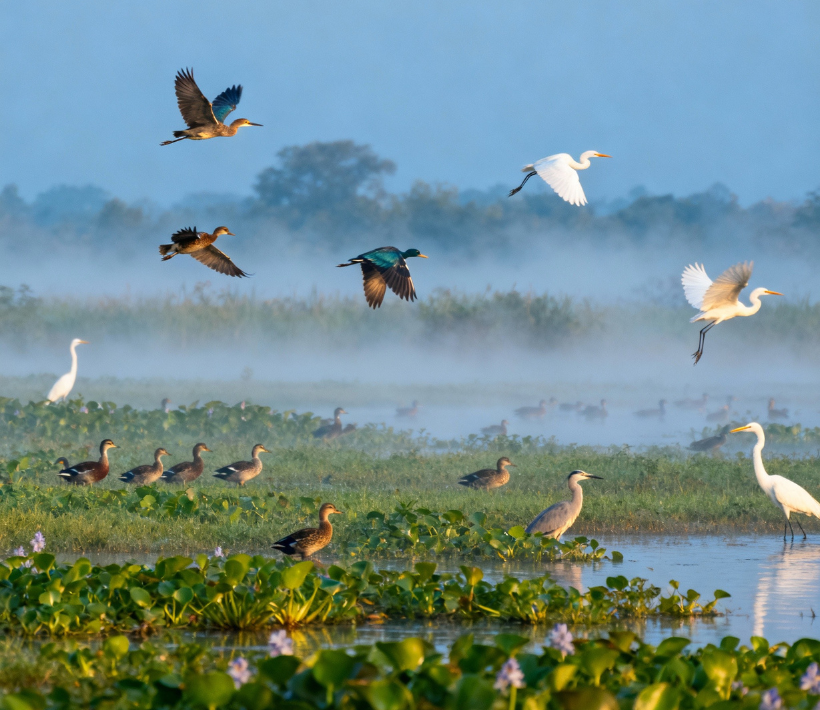
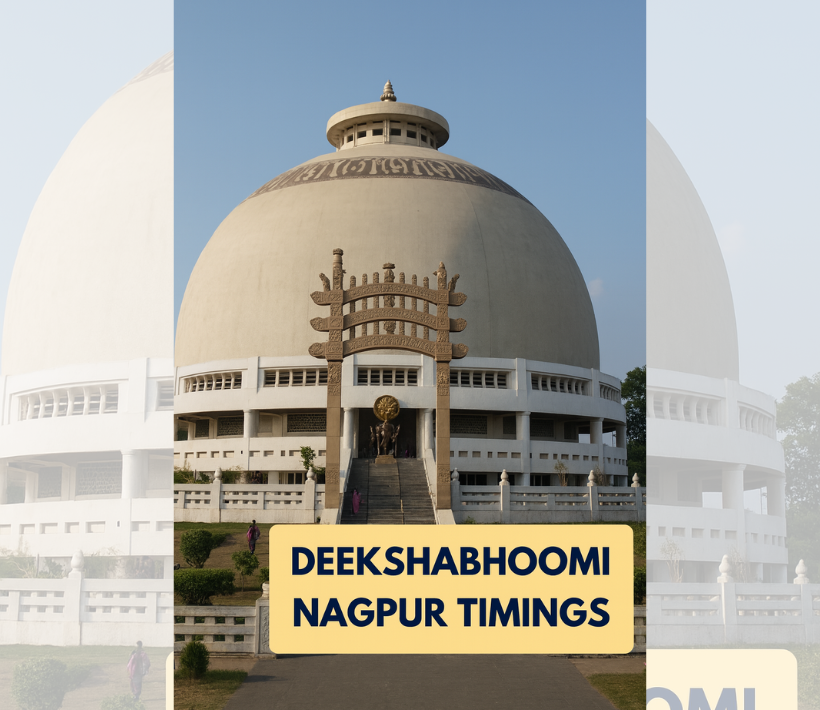
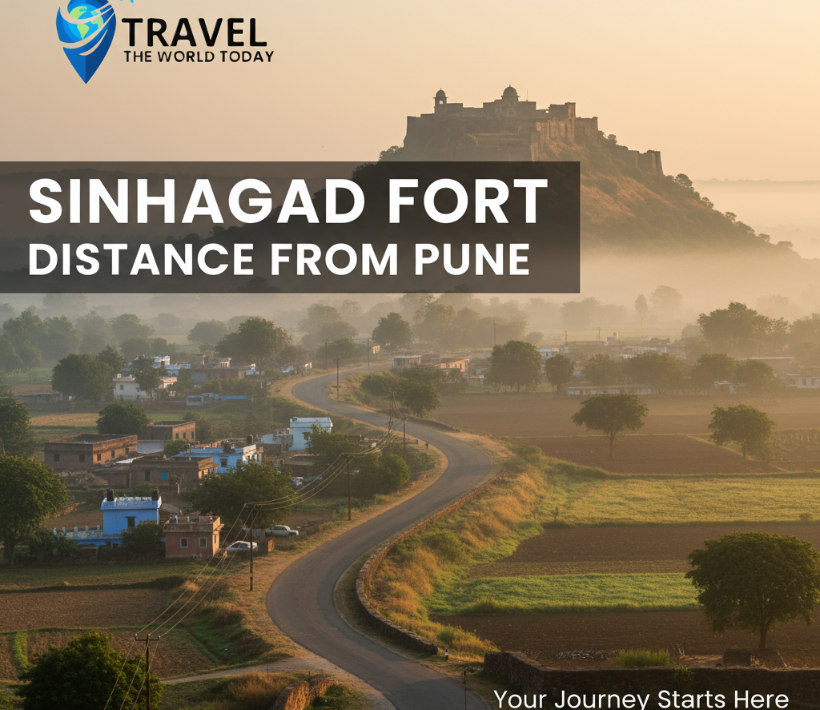

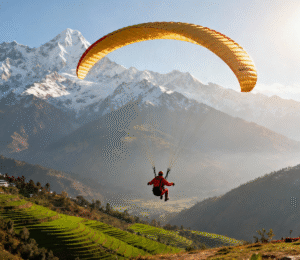
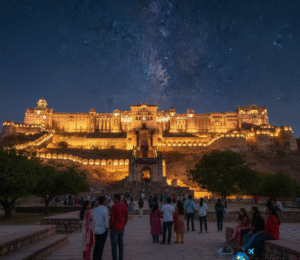

Post Comment